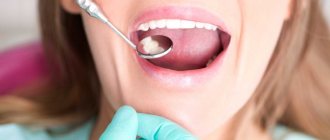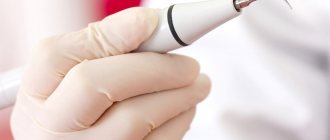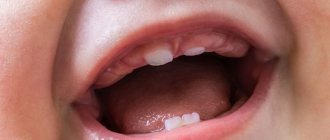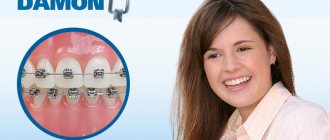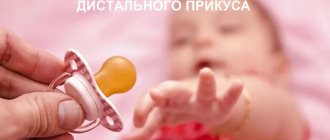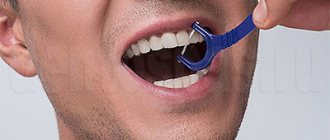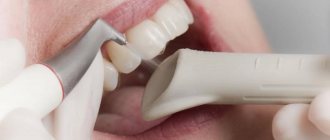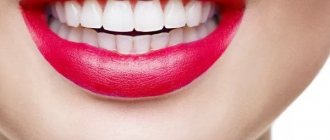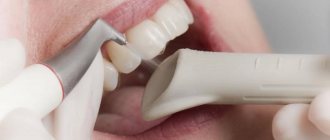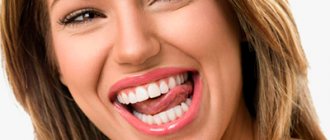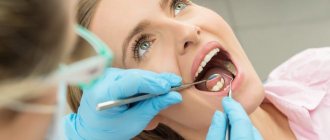A snow-white and healthy smile always leaves a pleasant impression of a person. But to maintain dental health, you need to brush your teeth thoroughly every day. Unfortunately, not everyone has enough time and patience to complete the entire range of hygiene procedures for oral care. But most people have the opportunity to have snacks throughout the day, drink sweet tea and coffee with baked goods, without thinking about the health consequences. All this leads to the formation of dental plaque, which many do not even try to fight, and if they do, it is done exclusively on their own. Is it possible to remove tartar at home? What modern way will return your smile to its former beauty in no time? Look for answers in our article.
Tartar: causes of appearance
Plaque forms on the surface of teeth in absolutely all people and is a soft biofilm consisting of food molecules and microorganisms. Soft plaque can be easily removed with a brush, floss and rinse. But in the absence of proper hygiene, it begins to thicken, darken, and after a few weeks mineralizes to the stage of stone.
In addition to untimely hygiene, the reasons for the formation of hard dental plaque can be:
- smoking
- excessive consumption of sugar and carbohydrates
- digestive diseases
- malocclusion
- use of poor quality hygiene products
- hereditary predisposition
What kind of improvised means did people use to clean teeth from tartar before the advent of the modern toothbrush? They used coal, iron, salt, tree bark, coconut oil, chili pepper, cloth and other available means.
Standard method of brushing teeth Pakhomova G.N.
This method is recommended by most Russian dentists. It was invented by G.N. Pakhomov - professor of dentistry.
- Cleaning begins from the upper jaw in the following order - from the right molars to the front ones, then finishes on the left molars.
- On the lower jaw, the left major ones are cleaned first, then the anterior ones, and lastly the right molars.
- The front and back surfaces are cleaned with sweeping movements from bottom to top, with the brush head at an angle of 45° to the gum.
- It is important to make 10 movements for each tooth.
- Contaminants from the chewing side are removed by moving the head back and forth.
- To clean the front teeth, the brush is placed vertically and moved in a sweeping motion.
The Pakhomov method helps to effectively clean the oral cavity, but for the interdental spaces additional means are needed - irrigators, threads and a tongue scraper.
Why is tartar dangerous?
Such a seemingly trivial problem as plaque and tartar often remains without proper attention. Just think, not entirely aesthetically pleasing. Your teeth don’t hurt, which means there’s nothing to treat. But this is for the time being.
Microorganisms living in dental deposits multiply quickly and in the process of vital activity they release acids that spoil the enamel and lead to inflammation of periodontal tissues. Itching, swelling, bleeding, pain in the gums, increased sensitivity of enamel, halitosis (bad breath), caries are the deplorable results of an indifferent attitude towards one’s health. But all this can be avoided if you clean your teeth from tartar in a timely manner.
For many, removing stones from teeth using improvised means seems obvious and easily accessible, especially now, when there is a lot of useful advice on the Internet for any problem. But the most dangerous thing in all this is that these recommendations are given by people who do not even have a basic medical education. These methods of cleaning tartar are, of course, absurd.
Let us present two folk remedies against tartar and explain from a medical point of view why they are ineffective.
Recipe one
Grate the black radish and add lemon juice to it. Brush your teeth with the resulting mixture in the morning and evening.
Doctor's explanation:
This elixir contains acid. Indeed, more than 25 years ago, before removing tartar from teeth with instruments, doctors used a special acid that softened it. But at home, even softened dental plaque cannot be removed using improvised means. But you can easily get increased sensitivity of the enamel as a complication.
Recipe two
Prepare a decoction of walnut bark. Wet your toothbrush with the broth and brush your teeth with it three times a day for 2-3 minutes.
Doctor's explanation:
Brushing your teeth 3 times a day for 2–3 minutes is a standard recommendation from dentists. But in terms of effectiveness, walnut decoction can be compared to drinking water. Try brushing your teeth without toothpaste - you will only be able to remove soft plaque. And neither a high-quality brush, nor a herbal decoction, nor even the most advertised toothpaste can cope with hard, mineralized deposits on the teeth.
From all of the above we draw a conclusion.
What is an interdental irrigator?
This is a convenient device for effective oral hygiene. With the help of the Waterpik irrigator, the standard teeth cleaning procedure moves to a higher quality level, similar to a professional service in a dentist's office.
The device consists of a hydraulic pump (compressor), a reservoir for flushing fluid and a handle on which the nozzles are attached. When turned on, the compressor creates pressure, creating a powerful pulsating jet of water. Through the nozzle, it gets into the interdental crevices and easily washes out plaque and food debris from them.
Waterpik irrigators are stationary and portable. Devices with a built-in charging battery are compact in size and can be taken with you to work or on the road. This is especially convenient for those who wear braces. Stationary devices are connected to the electrical network, they are large in size and have a large tank.
Ultrasound is a modern way to combat tartar
Preventive cleaning of teeth from stone with ultrasound has long been a mandatory procedure in civilized countries. In our country, there is no such practice yet, so patients are more negligent about their health and most often turn to the dentist when there are obvious health problems.
The procedure for cleaning teeth with an ultrasonic scaler in dentistry is carried out by a hygienist or periodontist. The specialist assesses the condition of the teeth and gums, excludes contraindications, selects the necessary attachment for the device and begins treatment.
In case of increased sensitivity of the enamel and deep cleaning of the subgingival area, the doctor may use local anesthesia - this will make the patient more comfortable during the procedure.
Under the influence of high-frequency ultrasonic vibrations, any dental deposits are destroyed, and pathogenic bacteria are destroyed from the surface of the teeth and from periodontal pockets. Ultrasonic cleaning lasts about an hour and ends with an enamel polishing procedure. You will not only see, but also feel the result: your teeth will become clean, smooth - and no hint of dark plaque.
In children, teeth cleaning from tartar and plaque with ultrasound is carried out after changing the primary bite to a permanent one and exclusively for medical reasons.
Despite the fact that ultrasonic cleaning is a safe procedure, it has a number of contraindications:
- general somatic diseases in acute form
- colds and ARVI
- infectious diseases
Ultrasound should be used with caution in patients with an artificial cardiac pacemaker.
Ultrasonic tartar removal is the most effective and fastest way to make your smile attractive again. For preventive purposes, this procedure is recommended to be carried out every six months, and for those who wear braces, even more often - once every 3 months.
Interdental space
One of the problem areas of the oral cavity is the interdental space, so dentists of all specializations pay maximum attention to this area. Damage to this anatomical area can lead to the formation of caries on the proximal surfaces of the tooth, the treatment of which is the responsibility of the dentist. Periodontists also encounter difficulties in proper hygiene of the interdental zone in patients, and it is difficult for orthopedists to model the contact point. Regular toothpaste and brush cannot provide the necessary care for this area. Therefore, many people suffer from caries of contact surfaces from an early age, when the teeth are still baby, and in adulthood, when the molars are already exposed to caries.
What hygiene products are available for cleaning interdental spaces?
Interdental spaces require special care with the help of interdental oral hygiene products: toothpicks, floss, tapes and flossettes.
Toothpicks are available in plastic, wood and bone china. The most common toothpicks are made of soft wood or polymers. The sharp, cone-shaped edge follows the space between the teeth, making it easy to remove stuck food without damaging the gums.
Dental floss for the hygiene of contact surfaces of teeth has another name - dental floss. This is a very popular remedy for maintaining oral health. It is made from single-fiber, heavy-duty material, coated with a semi-liquid paraffin composition, temperature above 50°C. Then the thread is cooled and given the desired shape. To flavor the thread, an additional paraffin layer is applied to the fiber, the melting degree of which is lower than the first.
Tape (tare) is a wide floss that is approximately 5 times wider than the fiber of dental floss. The tape is made specifically for people with large interdental spaces and for those who have just started using such hygiene products.
Superfloss was created specifically for cleaning the interdental space, as well as for the hygiene of orthodontic systems. It has 3 functional parts: first a hard fiber part for quickly inserting floss under or between the structure, then a nylon space for removing food debris and plaque, and the last one is a standard floss. According to the results of clinical studies, the use of superfloss is 60% more effective than regular dental floss.
A toothbrush for contact areas of teeth (interdental toothbrush) is an analogue of a regular toothbrush with the only difference being the size, number of tufts and the shape of the brush area. There are three types of haircuts with single-tuft or mono-tuft brushes:
- flat to one level;
- cone-shaped in several levels;
- multi-level in the form of a truncated cone.
A low-tuft toothbrush typically has at least 6–7 tufts of bristles. The basis of the bristles is nylon fiber.
Another means of hygiene for the proximal surface of the tooth is toothbrushes . Their handle is completely identical to regular toothbrushes, but the brush itself is made of twisted wire with short bristles.
Which cleaning product should you choose?
Despite such a wide variety of oral hygiene methods, classic dental floss occupies a leading position in popularity. There are three types of floss:
- with microcrystalline wax (paraffin) or fluorine wax (waxed);
- without wax (unwaxed), but with a weak wax impregnation;
- with wax and menthol shock absorber (mint waxed), etc.
Some flosses are designed specifically for the hygiene of orthodontic and orthopedic structures.
Dental floss comes in small plastic boxes that easily fit into a woman’s purse or pocket. The meter of the thread can be from 18 to 50 meters. Such packaging is economical and easy to use, so a person can use floss at any time necessary.
To quickly restore the pH balance of the oral cavity after eating, it is recommended to use a floss containing fluoride components, usually sodium fluoride. But to maintain the cleanliness and hygiene of the interdental space, it is better to clean these areas with a toothpick with a triangular tip, and only then use dental floss.
What to do to avoid the formation of tartar on your teeth
Take preventive measures:
- do not forget to brush your teeth thoroughly in the morning and evening
- purchase quality household hygiene products
- Don’t limit yourself to just one toothbrush: use flosses, irrigators, rinses
- avoid frequent snacking, balance your diet
- after eating, rinse your mouth with water
- less soft, high-calorie food, more solid and healthy food
- watch your health
- Visit your dentist and hygienist regularly
These simple tips will allow you to eliminate the first signs of dental plaque in time and reduce the risks of developing caries and periodontitis, which will be more difficult and expensive to treat.
Come to the Center for Modern Dentistry. Our specialists will teach you home hygiene techniques, tell you which brush and paste you need to use, and completely remove stubborn plaque in an effective and affordable way without harm to your health.
Toothbrush. Proper Use
The toothbrush should be positioned at a 45° angle to the gum line. Make sweeping movements in an up and down direction. Repeat the procedure on all external tooth surfaces.
Cleaning the inner surfaces of teeth is carried out in a similar way. After hygiene of the chewing surfaces, you need to use the tip of the brush to pass the inner surfaces of the upper and lower teeth, both up and down and back and forth.
Don't forget that bacteria are also on the tongue. Therefore, it also needs to be cleaned.
Research results
Current research indicates a slight advantage to electric toothbrushes. Adults and children who used a power brush to clean their mouths showed an 11 percent reduction in plaque on their teeth and were less likely to experience gingivitis and other gum diseases than people who used a manual toothbrush.
Additionally, the researchers found that brushes with small round heads that spin quickly in one direction and then the other did a slightly better job of removing plaque than brushes with oval heads that move quickly or vibrate from side to side. But the study authors say more research is needed to confirm these results.
Another study found that using an electric toothbrush reduced the progression of periodontal disease. Additionally, power toothbrush users had healthier gums overall and 19 percent more teeth over the study period than those who used manual brushes.
However, you can effectively brush your teeth with a regular manual toothbrush.

